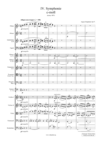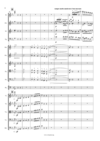4th Symphony (Klughardt)
The Symphony No. 4 in C minor, Op. 57, is a symphony composed by August Klughardt in 1890 and published in 1892 .
description
Hermann Kretzschmar wrote about the symphony in his guide through the concert hall :
“Klughardt's fourth symphony (C minor, op. 57) is one of the most noteworthy and captivating mood symphonies that we have received recently. The lion's share of her spiritual content and artistic execution falls on the first movement, which, in a manner similar to that in the double concerto and in other works by Brahms, almost overshadows the rest. He unrolls a picture for clarification and feelings struggling for freedom, a picture in which hard struggles and friendly hopes confront each other. The composer reveals his greatest musical power in the second half of the development, where shocking and touching notes strike him at the first moment. The full effect of the sentence is somewhat opposed to the intricate nature of the main theme, which is veiled in accessories. One of the nicest moments is the bold, brightening horn theme.
The second movement is based on a chorale style. In their peace there breaks in a middle sentence, wild and demonic; but unsuccessful. The freedom of invention and design, which is a hallmark of this whole Andante, is most beautifully expressed at the end of this dramatic episode with the entry of the cello theme.
The third movement (Presto) is a Scherzo modeled after Beethoven and with unseen echoes of him. The trio introduced by horns speaks of the excellent talent for noble folk tunes, which also distinguish Klughardt's operas.
The same Marschner talent manifests itself in the marching movement that makes up the main part of the finale; An artistic treatment that works here and there with the joint shape that Klughardt liked to use raises him to higher circles. The demonic ghosts of poetry speak again imperiously from the slow introduction of the movement, which overlaps several times in its course and which must be considered the most important section of the finale. "
score
Pages 1 to 6:

|

|

|

|

|

|
Individual evidence
- ^ Hermann Kretzschmar: Guide through the concert hall , 3rd edition, Leipzig 1898, p. 681.
Web links
- 4th Symphony (Klughardt) : Sheet music and audio files in the International Music Score Library Project